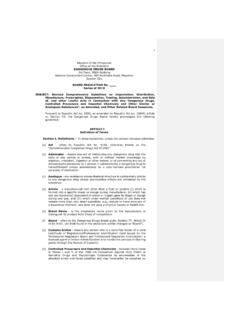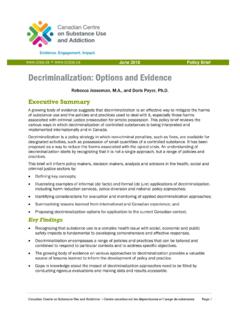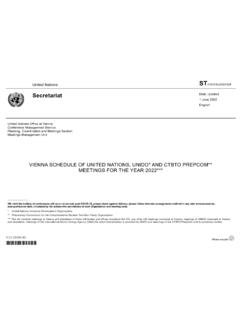Transcription of Philippine Anti-Illegal Drugs Strategy
1 1 | P a g e Philippine Anti-Illegal Drugs Strategy 2 | P a g e CONTENTS Acronym List 3 Foreword 1. Background The Need for a Comprehensive and Balanced Anti-Illegal Drugs Strategy The Anti-Illegal Drugs Strategy Statement 6 7 10 2. The Global drug Situation World drug Report 2017 The Cost of drug Use and Dependence International Anti-Illegal Drugs Strategies and Outcomes 11 11 12 14 3. The Philippine drug Situation Issues, Challenges, and Priorities Working Toward the Needed Solution 17 21 24 4. The Two-Component Anti-Illegal Drugs Strategy : Progress and Achievements drug Supply Reduction drug Demand Reduction 28 30 37 5.
2 Ensuring Accountability Monitoring and Evaluation System Reporting Mechanism 48 48 51 6. Call to Action 54 References List of Figures List of Tables 55 58 59 Annexes Annex 1 Glossary Annex 2 Functions of Different Agencies Annex 3 Indicators and Data Collection Plan 60 60 61 73 3 | P a g e Acronym List AAR After Activity Report ADAC Anti- drug Abuse Council ADS African drug Syndicates AIDS Acquired Immune Deficiency Syndrome AMLC Anti-Money Laundering Council AMS ASEAN Member States APSC ASEAN Political Security Community ASEAN Association of Southeast Asian Nations ATCPDE ASEAN Training Center for Preventive drug
3 Education ATS Amphetamine Type Substances BADAC Barangay Anti- drug Abuse Council BDCP Barangay drug Clearing Program BKD Barkada Kontra Droga BR Board Regulation CHED Commission on Higher Education CPEC Controlled Precursors and Essential Chemicals CSO Civil Society Organizations DAPC drug Abuse Prevention and Control DAPE drug Abuse Prevention and Education DAPP drug Abuse Prevention Program DATRC drug Abuse Treatment and Rehabilitation Center DARE drug Abuse Resistance Education DBM Department of Budget and Management DDB Dangerous Drugs Board (also referred to as the Board ) DDE drug Dependency Examination DepEd Department of Education DEU drug Enforcement Unit DFA Department of Foreign Affairs DI Directorate for Intelligence DILG Department of the Interior and Local Government DOF Department of Finance DOH Department of Health DOJ Department of Justice DOLE Department of Labor and Employment DND Department of National Defense DOTr Department of Transportation DSWD Department of Social Welfare and Development EU European Union FDAPP Family drug Abuse Prevention Program GDP Gross Domestic Product 4 | P a g e GOCC Government-Owned and Controlled Corporations
4 HARP HIV/AIDS and ART Registry of the Philippines HIV Human Immunodeficiency Virus HVT High-Value Target IBP Integrated Bar of the Philippines ICAD Inter-Agency Committee on Anti-Illegal Drugs ICCE International Centre for Credentialing and Education of Addiction Professionals IDADAIT International Day Against Drugs and Illicit Trafficking IDDI Illicit drug Diversion Initiative IDTOMIS Integrated drug Test Operation and Management Information System IEC Information, Education, and Communication IRA Internal Revenue Allotment KALAHI-CIDDS Kapitbisig Laban sa Kahirapan-Comprehensive and Integrated Delivery of Social Services LGU Local Government Unit LTFRB Land Transportation Franchising and Regulatory Board M & E Monitoring and Evaluation MAT Medication-Assisted Treatment MI Motivational Interviewing NADPA National Anti- drug Plan of Action NBI National Bureau of Investigation NDEP National drug Education Program NEDA National Economic Development Authority NGA National Government Agency NGO Non-Government Organization NPS New Psychoactive Substances NSP Needle and
5 Syringe Program NYC National Youth Commission ONDCP Office of National drug Control Policy OSHC Occupational Safety and Health Center PADS Philippine Anti-Illegal Drugs Strategy PAP Programs, Activities, and Projects PDE Preventive drug Education PDEA Philippine drug Enforcement Agency PDP Philippine Development Plan PO People s Organization POC Peace and Order Council POI Program of Instruction PNP Philippine National Police PSRSD Policy Studies, Research, and Statistics Division (DDB) 5 | P a g e PWID People Who Inject Drugs PWUD People Who Use Drugs REECS Resources, Environment and Economics Center for Studies SDEC Special drug Education Center SEAP Self-Employment Assistance Program SFP Strengthening Families Program SHN School Health and Nutrition STAND Street Artists.
6 No to Drugs START Strategies Toward Acceptance, Reintegration, and Transformation SUD Substance Use Disorder SWD Social Welfare and Development TESDA Technical Education and Skills Development Authority TRC Treatment and Rehabilitation Center UN United Nations UNAIDS United Nations Programme on HIV/AIDS UNGASS United Nations General Assembly Special Session UNODC United Nations Office on Drugs and Crime US United States WHO World Health Organization 6 | P a g e 1 Background Illicit drug production, trafficking, and use remain a matter of shared concern as they hinder development and pose a threat to security among countries across the globe.
7 Their profound and devastating effects know no boundary in terms of ethnicity, religion, geographic location, political affiliation, educational background and socio-economic status. Health, a crucial prerequisite and resource for development, is adversely affected as drug use impacts both morbidity and mortality. Notably, drug use has also been shown to be associated with other risky behaviors such as drunk driving, unprotected sex, and needle-sharing, which can lead to hepatitis and HIV-AIDS. It is also an important correlate of medical and psychiatric co-morbidities, intentional injuries, and death.
8 In terms of its significant social and economic consequences, drug use can lead to lowered productivity due to occupational diseases and injuries, higher health care costs, spread of infectious diseases, and family breakdown, to name a few. drug -related crimes and violence escalate, diverting resources initially allocated for social services into law enforcement and the criminal justice system. Also contributing to societal burden is the negative outcome from drug use that young people may experience during their most productive years. Thus, investing in efforts that would deter people, especially the youth, from using illicit Drugs would greatly benefit society.
9 drug abstinence can lead to better learning outcomes, healthier families, more productive workforce, safer communities, and longer life expectancy. Investing in both drug supply and drug demand reduction programs will pay dividends for the years to come. It will shape the future of the next generation of Filipinos and will dramatically transform the landscape of Philippine security. 7 | P a g e The Need for a Comprehensive and Balanced Anti-Illegal Drugs Strategy Because it creates complex health and social problems, the drug issue is undoubtedly a public health challenge that must be prioritized.
10 In 2009, United Nations Member States adopted the Political Declaration and Plan of Action on international cooperation towards an integrated and balanced Strategy to counter the drug menace. The UN General Assembly, of which the Philippines is a member, declared that the world drug problem remains a common and shared responsibility that requires effective and increased international cooperation and demands an integrated, multidisciplinary, mutually-reinforcing and balanced approach to supply and demand reduction strategies. In April 2016, the United Nations General Assembly Special Session (UNGASS) on the World drug Problem provided a platform for debate on how the global community should respond to this pressing concern.











